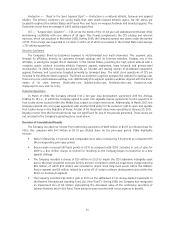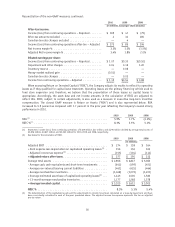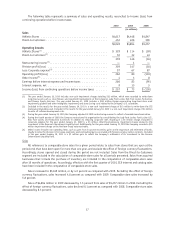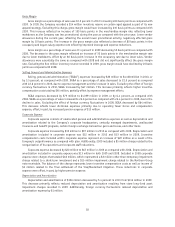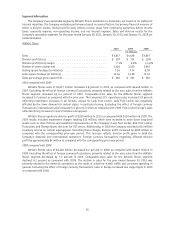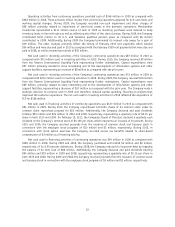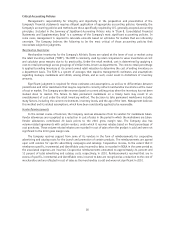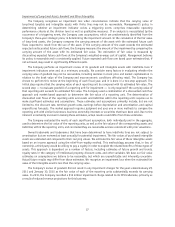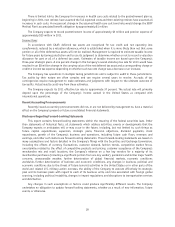Foot Locker 2010 Annual Report Download - page 41
Download and view the complete annual report
Please find page 41 of the 2010 Foot Locker annual report below. You can navigate through the pages in the report by either clicking on the pages listed below, or by using the keyword search tool below to find specific information within the annual report.
Liquidity and Capital Resources
Liquidity
The Company’s primary source of liquidity has been cash flow from operations, while the principal uses of
cash have been to: fund inventory and other working capital requirements; finance capital expenditures related
to store openings, store remodelings, information systems, and other support facilities; make retirement plan
contributions, quarterly dividend payments, and interest payments; and fund other cash requirements to support
the development of its short-term and long-term operating strategies. The Company generally finances real
estate with operating leases.
Management believes its cash, cash equivalents, future cash flow from operations, and the Company’s current
revolving credit facility will be adequate to fund these requirements. The Company may also from time to time
repurchase its common stock or seek to retire or purchase outstanding debt through open market purchases,
privately negotiated transactions or otherwise. Such repurchases, if any, will depend on prevailing market
conditions, liquidity requirements, contractual restrictions, and other factors. The amounts involved may be
material.
Any material adverse change in customer demand, fashion trends, competitive market forces or customer
acceptance of the Company’s merchandise mix and retail locations, uncertainties related to the effect of
competitive products and pricing, the Company’s reliance on a few key vendors for a significant portion of its
merchandise purchases, and risks associated with foreign global sourcing or economic conditions worldwide
could affect the ability of the Company to continue to fund its needs from business operations.
Maintaining access to merchandise that the Company considers appropriate for its business may be subject
to the policies and practices of its key vendors. Therefore, the Company believes that it is critical to continue to
maintain satisfactory relationships with its key vendors. In 2010 and 2009, the Company purchased
approximately 82 percent of its merchandise from its top five vendors and expects to continue to obtain a
significant percentage of its athletic product from these vendors in future periods. Approximately 63 percent in
2010 and 68 percent in 2009 was purchased from one vendor — Nike, Inc.
Planned capital expenditures for 2011 are approximately $153 million, of which $116 million relates to
modernizations of existing stores and the planned opening of 60 new stores, and $37 million is allocated for the
development of information systems and other support facilities. In addition, planned lease acquisition costs
related to the Company’s operations in Europe are $7 million. The Company has the ability to revise and
reschedule much of the anticipated capital expenditure program, should the Company’s financial position require
it.
Cash Flow
Operating activities from continuing operations provided cash of $326 million in 2010 as compared with
$346 million in 2009. These amounts reflect income from continuing operations adjusted for non-cash items and
working capital changes. Non-cash impairment and other charges were $10 million and $36 million for the years
ending January 29, 2011 and January 30, 2010, respectively. The Company recorded a $10 million impairment
charge in 2010 related to its CCS tradename. The 2009 charges totaled $36 million, comprised of $32 million to
write-down long-lived assets such as store fixtures and leasehold improvements at the Company’s Lady Foot
Locker, Kids Foot Locker, Footaction, and Champs Sports divisions and $4 million to write off software
development costs. During 2010, the Company contributed $32 million to its U.S. and Canadian qualified pension
plans as compared with $100 million contributed in 2009. The change in merchandise inventory, net of the
change in accounts payable, as compared with the prior-year period, represents inventory required to support the
favorable sales trend. During 2010, the Company paid $24 million to settle the liability associated with the
terminated European net investment hedge, whereas in the prior-year period the Company terminated its interest
rate swaps and received $19 million.
22




